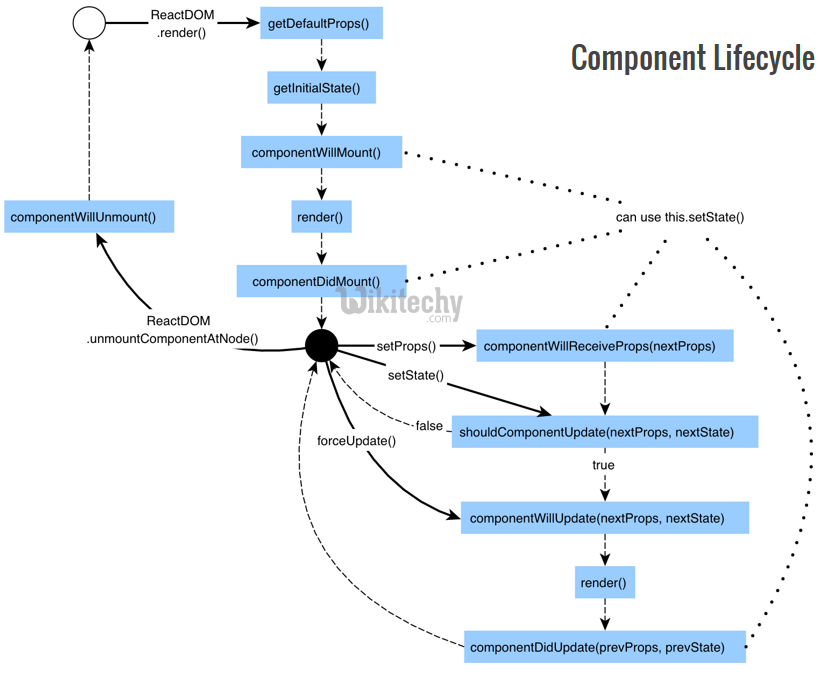The next phase in the lifecycle is when a component is updated. React has five built-in methods that gets called in this order when a component is updated.

Understanding React Component Life Cycle By Bartosz Szczecinski Medium
This method is called only when the component gets updated or when the props passed to it change.

React class component did update. Inside the method we can check if a condition is met and perform an action based on it. All updates are fired through ComponentDidUpdate. A component is updated when there are changes made to the components props or state.
When this happens the component is re-evaluated and goes through a different lifecycle than the creation lifecycle. ComponentDidUpdate takes as its first two arguments the previous props and the previous state. The componentDidUpdate function is a part of a React components life cycle.
The componentDidUpdateis called after componentDidMount and can be useful to perform some action when the state of the component changes. ComponentDidMount is invoked immediately after a component is mounted inserted into the tree. Forcing component to re-render.
This might happen if new props have been provided by a parent component or an internal state has been changed. Here are the steps you need to follow for using asyncawait in React. Use await in the functions body.
All the network requests that are to be made when the props passed to the component changes are coded here. The componentDidUpdate and other life cycle methods apply only to React Class components. The componentDidMount method is a great place to request data from the server since even though setting the state will cause a second render it happens before the browser updates the screen.
Every React component has lifecycles and one of those are componentDidUpdate. React generally re-renders the component whenever the component state or props are changed and we see the updated UI. Function prevProps prevState.
The first parameter for this method is the props before the update. Last Updated. According to the React documentation.
04 Feb 2021 React class based components are the bread and butter of most modern web apps built in ReactJS. The componentDidUpdate method allows us to execute the React code when the component is updated. Use that interface for anything that is going to happen when the state is updated.
All class based components are child classes for the Component class of ReactJS. ComponentDidMount consolelogcomponentDidMount lifecycle. This lifecycle gets called when a React component state or prop value has been updated.
If you use Fetch API in your code be aware that it. In this tutorial we are going to learn about how to force update the react class-based components and also functional components. ReactJS componentDidUpdate Method.
It is called when a component got updated. Class App extends ReactComponent state foo. GetDerivedStateFromProps shouldComponentUpdate render getSnapshotBeforeUpdate componentDidUpdate.
React then calls the Clock components render method. Put the async keyword in front of componentDidMount. React then updates the DOM to match the Clocks render output.
Render consolelogRender lifecycle return Hello Look at the example above. For this component the method will look like this. ReactJS Web Development Front End Technology.
We will later update this state. So testing whether a prop has changed can be done here. Whenever a class component is updated the componentDidUpdate method is called.
In this article we are going to see how to execute a function when the component is updated in the DOM tree. These components are simple classes made up of multiple functions that add functionality to the application. Make sure to catch eventual errors.
When the Clock output is inserted in the DOM React calls the componentDidMount lifecycle method. In a class component you will use the componentDidUpdate method to trigger some side-effect for this lifecycle. Since this hook gives us state derived from the changes in props it is the very first lifecycle hook invoked when a component is.
ComponentDidUpdate is called after componentDidMount and can be useful to perform some action when the state changes. When is a component updated. React has a forceUpdate method by using that we can force the react component to re-render.
ComponentDidMount will only fire on the initialization of the component. Trigger update thissetState foo. A component is updated whenever there is a change in the components state or props.
This is how React learns what should be displayed on the screen.

React Component Lifecycle Dev Community

Componentdidupdate Prevstate Prevprops And A Silly Mistake By Ashley Wnj Medium

React Lifecycle Methods React Components Have Their Own By Rohit Kudale Stackavenue Medium
React Component Lifecycle Events By Joshua Blankenship Medium

React Lifecycle Methods An Approachable Tutorial With Examples Logrocket Blog

How To Use Componentdidupdate In React Dev Community

Cheatsheet To React Lifecycle Hooks Part 1 Dev Community

React Js Tutorial React Component Lifecycle Codevoila

Reactjs Lifecycle Of Components Geeksforgeeks

React Component Lifecycle With Hook Elanandkumar

Lifecycle State Getderivedstatefromprops And Hooks By Thomas Rubattel The Startup Medium The Startup

React 16 Lifecycle Methods How And When To Use Them By Scott Domes Bits And Pieces

Reactjs Lifecycle Initialization Mounting Updating Unmounting Cuelogic Technologies Pvt Ltd

The Lifecycle Of A React Component By Karina Guerra Codex Medium

How Does React Componentdidupdate Work

How To Use Componentwillmount In React Hooks Stack Overflow

React Tutorial Reactjs Component Life Cycle React Js Reactjs By Microsoft Award Mvp React Learn In 30sec Wikitechy

React Component Lifecycle Dev Community

Componentdidupdate Prevstate Prevprops And A Silly Mistake By Ashley Wnj Medium

0 Comments